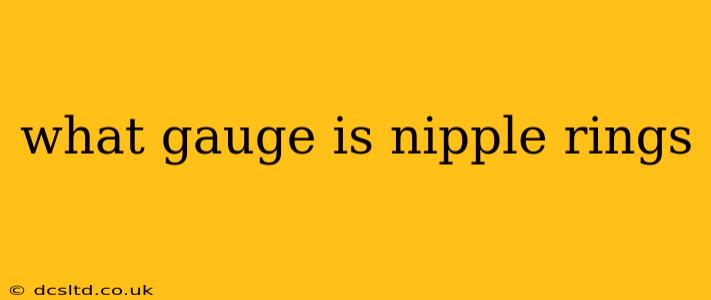What Gauge is Nipple Rings?
Nipple piercings, while beautiful and increasingly popular, require careful consideration of jewelry gauge to ensure both comfort and healing. Unlike other piercings, there's no single "standard" gauge for nipple rings. The ideal gauge depends on several factors, including the individual's anatomy, piercer's recommendations, and personal preference. However, understanding the common gauges used can help you make informed decisions.
What Gauges Are Commonly Used for Nipple Piercings?
Generally, nipple piercings are done with gauges ranging from 14 gauge (1.6mm) to 18 gauge (1mm). Let's break down the common gauges and what they mean:
-
14 Gauge (1.6mm): This is a very popular and often recommended starting gauge. It's considered a good balance between providing enough room for the jewelry to move freely (preventing irritation) and being substantial enough for strength and visibility. Many find it comfortable and less likely to migrate.
-
16 Gauge (1.2mm): This gauge is also relatively common and offers a slightly thinner look than 14 gauge. It is still robust and suitable for most people but might be better suited for those with smaller nipples or who prefer a more delicate look.
-
18 Gauge (1mm): This gauge is the thinnest commonly used and offers a subtle, minimalist look. However, it can be more prone to migration or rejection, especially in the healing phase. It’s generally not recommended for a first nipple piercing.
What Factors Influence Nipple Ring Gauge?
Several factors should influence the gauge your piercer chooses:
-
Nipple Anatomy: Larger nipples can accommodate thicker gauges comfortably, while smaller nipples might require a thinner gauge to prevent irritation or discomfort.
-
Piercer's Experience: A skilled piercer will assess your anatomy and make recommendations based on their expertise to minimize risks and complications. They'll also consider your preference, but safety and healing should always be paramount.
-
Personal Preference: While safety and practicality should guide your decision, you can discuss your aesthetic preferences with your piercer. They can help you choose a gauge that aligns with your desired look while remaining safe.
What Happens if the Gauge is Too Small or Too Large?
Choosing an inappropriate gauge can lead to several problems:
-
Too Small (Larger Gauge Number): This can cause significant discomfort, swelling, irritation, and an increased risk of rejection or migration. The piercing might be too tight and constrict blood flow.
-
Too Large (Smaller Gauge Number): While less likely to cause immediate problems, it can lead to the jewelry being too loose, potentially increasing the risk of infection, and the piercing might be more prone to migration.
Can I Change the Gauge After My Nipple Piercing Heals?
Once your nipple piercings are fully healed (this typically takes several months), you can potentially change the gauge with the assistance of a professional piercer. However, this should always be done by a qualified piercer who can ensure the correct procedure to avoid damaging the piercing or causing further complications. Attempting to change the gauge yourself can result in significant damage and infection.
In Conclusion:
The best gauge for your nipple rings is a decision best made in consultation with a reputable and experienced piercer. Their expertise will help determine the most suitable gauge based on your individual anatomy and health, ensuring a safe and successful piercing. Don't hesitate to ask questions and thoroughly research the professional you choose before getting pierced.
